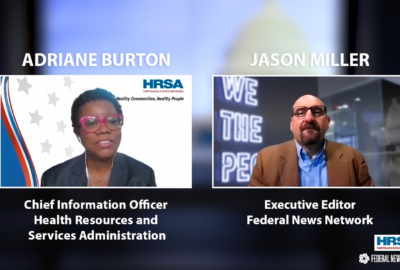How data improves customer service at the Health Resources and Services Administration
Service to the Citizen recently handed our dozens of awards to federal officials. At the very top of the list was Alek Sripipatana, the Director of Data and Eva...
An organization called Service to the Citizen, recently handed out dozens of awards to federal officials. At the very top of the list, Federal Drive with Tom Temin guest, Alek Sripipatana , Director of Data and Evaluation at the Health Resources and Services Administration (HRSA).
Interview Transcript:
Tom Temin And exactly what does the director of data and evaluation do at HRSA? Let’s start there.
Alek Sripipatana Well, it’s a very privileged position. I get to work with four teams within my division. If you think of the data lifecycle from the inception of a data point to being able to tee up our organizations to report on those data points with a level of accuracy and quality, that would be one team. The next part is once we have those data in our system, the analytical processes that are applied so that we can see if there are any particular trends or opportunities to enhance the program or better invest resources or deploy interventions. That would be the next part of my work and the second team. The third part of the team is the dissemination aspect. So once we have data in our system, we’ve done some really good analysis. We’ve looked at potential trends, we’ve identified some opportunities. We then have the privilege of sharing those data points with various folks, the public, folks who are policymakers, certainly folks within the bureau that make decisions about the program. And so our dissemination team, their primary work is making sure that we are sharing this information in a way that is digestible and applicable, ready to use across the continuum of data users. And then finally, the fourth team is our data modernization team. And that aspect of my work is how do we make these data points better? How do we improve the efficacy of the data? How do we improve the application of the data, improve the utility? How do we prove efficiency? How do we make life easier for our health centers to report on the data so that they can spend more time with their patients? And rightfully so. So that’s sort of the four areas of my division. And I get to oversee these teams and their work.
Tom Temin All right. And so you might say then that the ultimate purpose of the data that’s gathered process disseminated and then used and analyzed in some way really results in service to the 30 million people that are underserved that might use HRSA facilities to obtain their health care.
Alek Sripipatana Yes, absolutely. I know that we take each data point very seriously so we know that it represents a life, a community, a person. We care for those data in a way that we would care for people, and we make sure that we are telling the stories of our patients and our organizations that care for those patients.
Tom Temin Now, the organizations that provide health care in those often rural and underserved areas, they are not federal facilities, but there are people operating under the auspices of HRSA. What mechanism do you have to ensure that they are receiving the data that you’re sending them and the analysis, and that they use that in some way to say, How are we doing here with respect to the ultimate delivery of health care?
Alek Sripipatana It is quite a dynamic relationship. It’s quite bidirectional. So as a mandate of participation in the health center program, they have to deliver data to us on an annual basis. These data are called the Uniform Data System data, and it covers the gamut operational things about these facilities as well as the patients that they serve, their staffing, their financial situation and the like. So again, through our processes, we do a series of analyses and then we put these data in aggregate form back out into the public where these health centers can also be consumers. So they can see their own data, they can compare their data with other like health centers or other primary care facilities that are delivering care to the health care safety net.
Tom Temin And I imagine that as you see the data kind of come round and round again, I guess it gets more detailed and maybe more valuable with each round trip cycle. To put it crudely, there might be trends that HRSA can notice that you could maybe disseminate to everyone and saying, Hey, we’re finding that in these instances of this use of this procedure or this new drug, this is what tends to happen with these people or whatever, and then everybody can get in on it.
Alek Sripipatana Exactly. Exactly. We do our very best to push these data out into the public form for all sorts of potential patients of health. And again, policymakers, academics, the health centers themselves, just like you were mentioning, data is very cyclical. And I think that we have opportunities to improve data collection data reporting through each iteration as well as more importantly, how do we better inform these organizations? How do we better inform this program to better serve the patients’ communities?
Tom Temin We’re speaking with Alec Sripipatana. He is Director of Data and Evaluation at the Health Resources and Services Administration. And how did you come to this work? You’ve been at HRSA a few years now.
Alek Sripipatana Yes, sir. I’ve been privileged to be working for the Bureau of Primary Health Care for about ten years now. Quite honestly, it was a stroke of luck. I was actually on faculty at the University of California, Los Angeles. I happened to be at a meeting in Washington, DC. At that time, there was a call out for opportunities to work for the Bureau of Primary Health Care. I happened to meet the director at that time. My predecessor was actually at this meeting. We got to talking and saw some mutual career goals, professional goals, aspirations, and she said, you know what? How would you like to work for us? And I said, That would be a wonderful idea. And so I made sure to see if it was okay with the missus to move our family from California to Washington, DC. And every day has been better since the last.
Tom Temin And over the years. Have you seen an uptake in both medical practitioners, administrators of health care and maybe even patients themselves, greater willingness or even understanding of why they need to use data in the execution of their duties or in picking a place to get health care?
Alek Sripipatana Absolutely. You know, I think as a society as a whole, we’ve become more data informed folks in decision making. Whether you’re a consumer or a provider of services, you can track data trends, you can see where there are certain procedures that are more effective than others or certain clinical workflows that might be more effective than others. And then you can see those data in aggregate form through performance on clinical quality measures, let’s say, on that have very standard ways of reporting, clinical care or clinical outcomes with very defined numerators and denominators, specifications on inclusion and exclusion criteria. All that to say is, they’re a nice way to be able to benchmark where you’re at, where you want to be in current state or future state.
Tom Temin And of course the data warehouse is right there on the homepage of HRSA. It’s really open to the public. It’s not just the professional community that can access this data. What kind of uptake do you get on the data warehouse and do you monitor who’s looking at what?
Alek Sripipatana Absolutely. I mean, we do get to see interfaces. We don’t get specifics on who exactly is interfacing with her, the data warehouse. But we actually see the hit, the number of hits and we see the number of hits grow over time as the word gets out on this information, as well as folks familiarity and comfortability with using and engaging data. I will say that the various teams that are involved with pushing data out into the public sphere are quite conscientious and pushing data out in a way that is user friendly across a spectrum of users, from your more layperson to your more sophisticated academic.
Tom Temin And just a final question. In your day to day work, you interact with people doing data, but what about the medical side?
Alek Sripipatana Absolutely. You know, we do get opportunities to go visit our health centers for various reasons. In my line of work, what I’ll do is I’ll be deployed to a health center to see their medical workflows, their data workflows, and see if there are opportunities to enhance data quality data reporting or reduce the burden of reporting these data. And it’s a wonderful opportunity to get to talk with providers, really see what’s happening behind the scenes. You know, we do take these data points quite seriously because they do help inform the program, but it’s very good to keep in mind exactly how data are getting charted, how they’re being entered into an electronic health record system, an EMR. So it’s quite insightful. And one of the best parts of doing a site visit and and seeing our health centers is, I try and go to these places early and unannounced and I’ll take time and I’ll sit in the waiting room. You learn a lot about the organization, about the communities that we serve just by looking at the dynamics between the front desk staff and the patients, how they’re greeted, how they’re treated with respect, how they’re engaged, the pictures that are in a waiting room. It’s wonderful.
Tom Temin Interesting. And well, to follow up quickly, the centers that we’re talking about, these health care delivery centers, these are not primitive places where, you know, there’s an old enamel white counter and this kind of thing. These are fairly modern. They would look in place in any of the great suburban settings, too.
Alek Sripipatana Well, I will say that there are a host of health centers and they fall on a continuum depending on their environment. Right. So I think for perspective, we have nearly 1400 health care organizations or health centers, parent organizational health centers that represent over 14,000 delivery sites. This is across the United States stretching into the Pacific as well as the Atlantic. So given the context, you will see very sophisticated health centers, very sophisticated health centers. And HRSA does a great job in investing in these organizations to be able to update their care delivery environment and the like.
Copyright © 2024 Federal News Network. All rights reserved. This website is not intended for users located within the European Economic Area.
Tom Temin is host of the Federal Drive and has been providing insight on federal technology and management issues for more than 30 years.
Follow @tteminWFED






